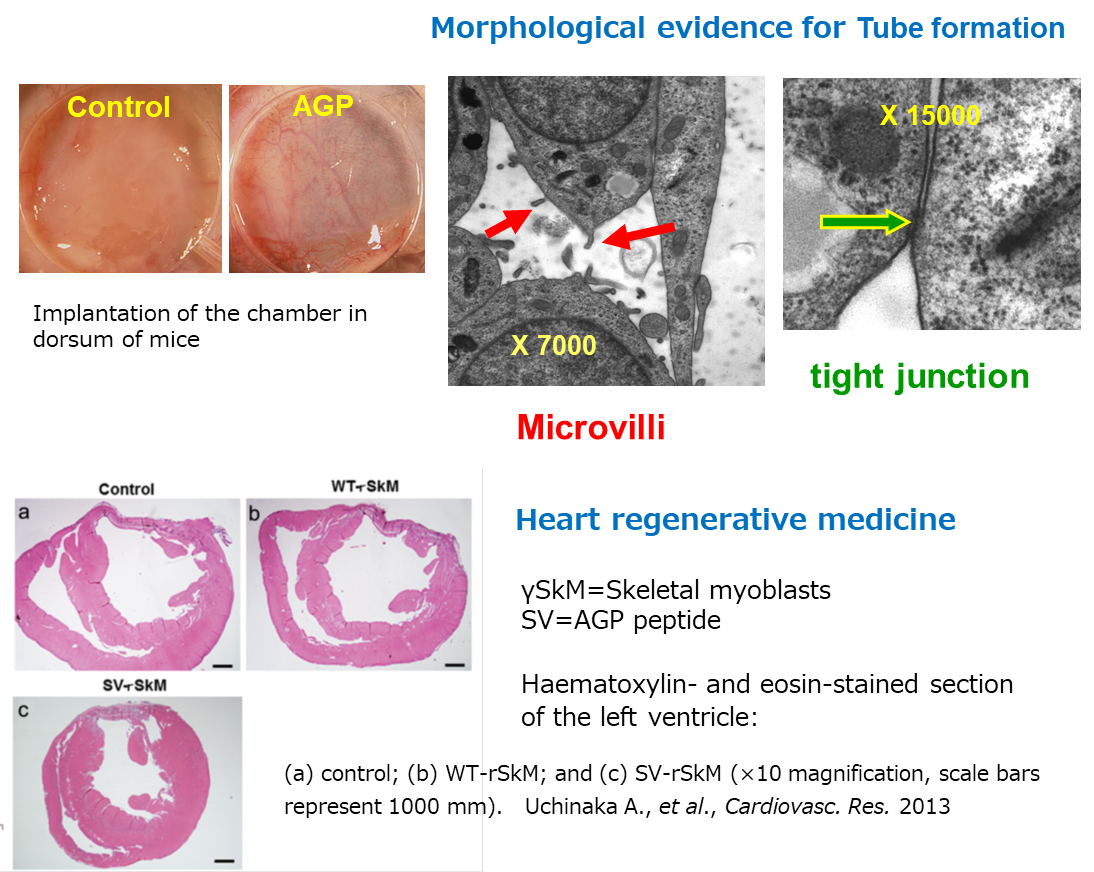Research tools & Theranostics
- Applications of immobilized cyclic-peptide Libraries (Diagnoses, Theranostics)
- Bioconjugates: Peptide-Vehicle (DDS/Therapeutics)
Angiogenic Peptide for Reconstruction Medicine
- Biomimetic, biodegradable and biocompatible materials for hard tissue reconstruction → highlighted for improving the QOL
- Further improvements → Functional peptides are immobilized directly on gelatin (collagen) → Replacement of hard tissues. Nokihara, K. et al, Peptide Science 2000, 373, 2001.
- Bioconjugates: transformed rat lung endothelial cells (Adhesion Assay Wound Assay) → directed towards cell adhesion and angiogenesis of endothelial cells. The Raito of Peptide vs. Carrier Protein had been optimized.
- In addition to the adhesion activity, a significant angiogenic activity exhibited peptide, designated AGP, angiogenic peptide has been discovered (USA EU & Japan-Patents). BBRC, 310,153-7, 2003.
Licensing, Material supply including library → Practical application (Preclinical to Clinical Phases)
1.Three dimensional cell culture was prepared to check the morphogenesis. Beside adhesion, we found tubular formation which was more pronounced for the AGP than VEGF
2.Normally monolayer-cultured endothelial cells do not show these cell differentiations.
3.Angiogenic effects were present in vitro. We have also carried out in vivo assays using the disc-angiogenesis-system with mice.
4.The peptide induced angiogenic effects were quantified according to the degree of newly formed blood vessels. We found that peptide AGP has a significant angiogenic activity.
5.The adhesion activity of AGP has already been reported but not its angiogenic properties.
6.No new blood vessels were observed in the control, VEGF induced neovalscularization moderately and the present AGP showed remarkable angiogenesis.
7.The results indicated that the residues located in the middle section of the peptide, in particular Tyr at position 4, are important while both the N- and C-termini are not crucial. Therefore immobilization at both ends of the peptide has no influence on its desired actions.
8.Novel biomimetic, biodegradable and biocompartible materials, which can be used for reconstruction of defective tissues, are in great demand.
9.Hence, both adhesion and angiogenesis are key factors for achieving the normal functioning of implanted artificial organs and for rapid healing.
| Contex | Paper |
| Angiogenic activity | Biochem. Biophys. Res. Commun. 310, 153-157, 2003 |
| Neovascularization in artificial bone marrow scaffold biomaterials | Dent. Mater. J. 26, 487-492, 2007 |
| Enhanced bone regeneration | Biomaterials 30, 4676-4686, 2009 |
| Tissue engineering biomaterials | Dent Mater J. 29, 1-8, 2010
J. Mater. Sci. Mater. Med. 23, 2761-2772 PLoS One 7, e41163,2012 |
| Tissue regeneration | Bioconjug. Chem. 23, 2042-2050, 2012 |
| Cardiac regeneration therapy | Cardiovasc Res. 99, 102-110, 2013
Mol Cell Biochem. 408, 191-203, 2015 Interact. Cardiovasc. Thorac. Surg. 21, 506-514, 2015 |
| HUVEC adhesion | Biomed. Mater. Res. A. 104, 1425-1436, 2016 |
Related pulications
1.Uchinaka A, Kawaguchi N, Hamada Y, Mori S, Miyagawa S, Saito A, Sawa Y, Matsuura N. Cardiovasc. Res., 99, 102-110, 2013.Transplantation of myoblast sheets that secrete the novel peptide SVVYGLR improves cardiac function in failing hearts
2.Egusa, H., Kaneda, Y., Akashi, Y., Hamada, Y., Matsumoto, T., Saeki, M., Thakor, D. K., Tabata, Y., Matsuura, N., Yatani, H. Biomaterials, 30, 4676-4686, 2009. Enhanced bone regeneration via multimodal actions of synthetic peptide SVVYGLR on osteoprogenitors and osteoclasts
3.Hamada, Y., Egusa, H., Kaneda, Y., Hirata, I., Kawaguchi, N., Hirao, T., Matsumoto, T., Yao, M., Daito, K., Suzuki, M., Yatani, H., Daito, M., Okazaki, M., Matsuura, N. Dent. Mater. J., 26, 487-492, 2007.Synthetic osteopontin-derived peptide SVVYGLR can induce neovascularization in artificial bone marrow scaffold biomaterials
4.Hamada, Y., Nokihara, K., Okazaki, M., Fujitani, W., Matsumoto, T., Matsuo, M., Umakoshi, Y., Takahashi, J., Matsuura, N. Biochem. Biophys. Res.Commun., 310, 153-157, 2003. Angiogenic activity of osteopontin-derived peptide SVVYGLR
5.Okazaki, M., Yamazaki, Y., Yoshida, Y., Shimadzu, A., Nokihara, K., Hamada, Y., Takahashi, J., and Matsuura, N. Dentistry in Japan, 37, 95-100, 2001.A New Concept of CO3 apatite Collagen Composites with Adhesion Motif as Biomaterials
6.Nokihara, K., Hamada, Y., Takahashi, J., Okazaki, M., and Matsuura, N. Peptide Science 2001, ed. Aoyagi, H., The Japanese Peptide Society, 359-362, 2002.Development of Biomedical Materials Carrying Immobilized Functional Peptides and Discovery of an Angiogenic Peptide
7.Nokihara, K., Blahunka, A., Yamazaki, Y., Yoshida, Y., and Okazaki, M. Peptide Science 2000, ed. Shioiri, T.,The Japanese Peptide Society, Osaka, 373-376, 2001.Development of Biomimetic Materials: Novel Composite Material Carrying Immobilized Functional Peptides



